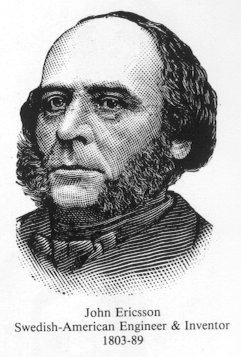The Monitor's Flush Toilet
Today, lessons from emerging technologies, under the worst conditions. The University of Houston's College of Engineering presents this series about the machines that make our civilization run, and the people whose ingenuity created them.
Item in a recent Houston Chronicle: divers sifting through the wreckage of the ironclad Union Monitor off Cape Hatteras had found a flush toilet. At first glance, a flush toilet aboard a ship may not seem impressive, but look for a moment at the context.
Before the Civil War, only the rich owned flush toilets. It'd be a decade before that famous plumber, Thomas Crapper, would popularize water closets. And on a ship, you used either a slop bucket or a hole in the edge of an upper deck. But most of the low-lying Monitor, crew included, rode below the waterline. It had a serious waste-disposal problem: Toilets depend on gravity, and gravity can do little good below water. Waste had to be forced out.
The Monitor's designer, Swedish engineer John Ericsson, had one of the most restlessly inventive minds of the 19th century. He solved the problem by creating a kind of mini-torpedo tube. After a sailor used the toilet, he had to close a near valve, open a far valve, then actuate a pump to drive the waste out. The system was fiendishly tricky to use. One sailor turned the valves in the wrong sequence and was blown off the seat by a powerful jet of seawater. Problems like that bedeviled the Monitor. It was one-of-a-kind all the way through. From its radical use of new screw propellers to its 120- ton turret, everything was new.
After Monitor's duel with the Merrimac (called the Virginia in the South) at Hampton Roads, both ships were thoroughly dented by point-blank fire but both survived. Monitor might've won had her crew better understood Ericsson's design in another matter, far more serious than waste removal:
They lost time closing gun ports for protection while they re-loaded. Late in the battle they discovered Ericsson's intent: simply rotate the port away from the enemy during reloading. They had also been afraid to fire astern for fear shock waves would split Monitor's boilers. Ericsson knew that wouldn't happen.
All technologies need time to teach their users, but there is no time in war. The ironclad Merrimac was poised to savage the Union Navy, and only the untested Monitor could stop it. So she moved in and stalemated the Confederates when she might've beaten them. Instead of victory, she left legacies -- like warship turrets and a flush toilet system that still serves submarines.
Ericsson was angry that his new technology hadn't been self-evident. He quit warships and set out to develop solar and tidal power systems. We've been even slower to assimilate them. More than any inventor, Ericsson's ideas came within inches of succeeding in their own time. Then they continued to teach us what they could do: the hot air engine, an early locomotive, screw propeller drives. But we users are the most important ingredient in any design. It takes us to complete the circle and make any invention a part of its world. Turrets, propellers -- and even flush toilets!
I'm John Lienhard, at the University of Houston, where we're interested in the way inventive minds work.
(Theme music)
Divers find flush toilet from Civil War ironclad. Houston Chronicle, July 28, 1998.
Dekay, J. T., Monitor: the Story of the Legendary Civil War Iron-clad and the Man Whose Invention Changed the Course of History. New York: Walker and Company, 1997.
I am grateful to Jim Bell, KUHF-FM Radio, and Jeff Fadell, UH Library, for suggesting this topic.
See also Episodes 151, 695, and 795 for more on Ericsson and the monitor.
